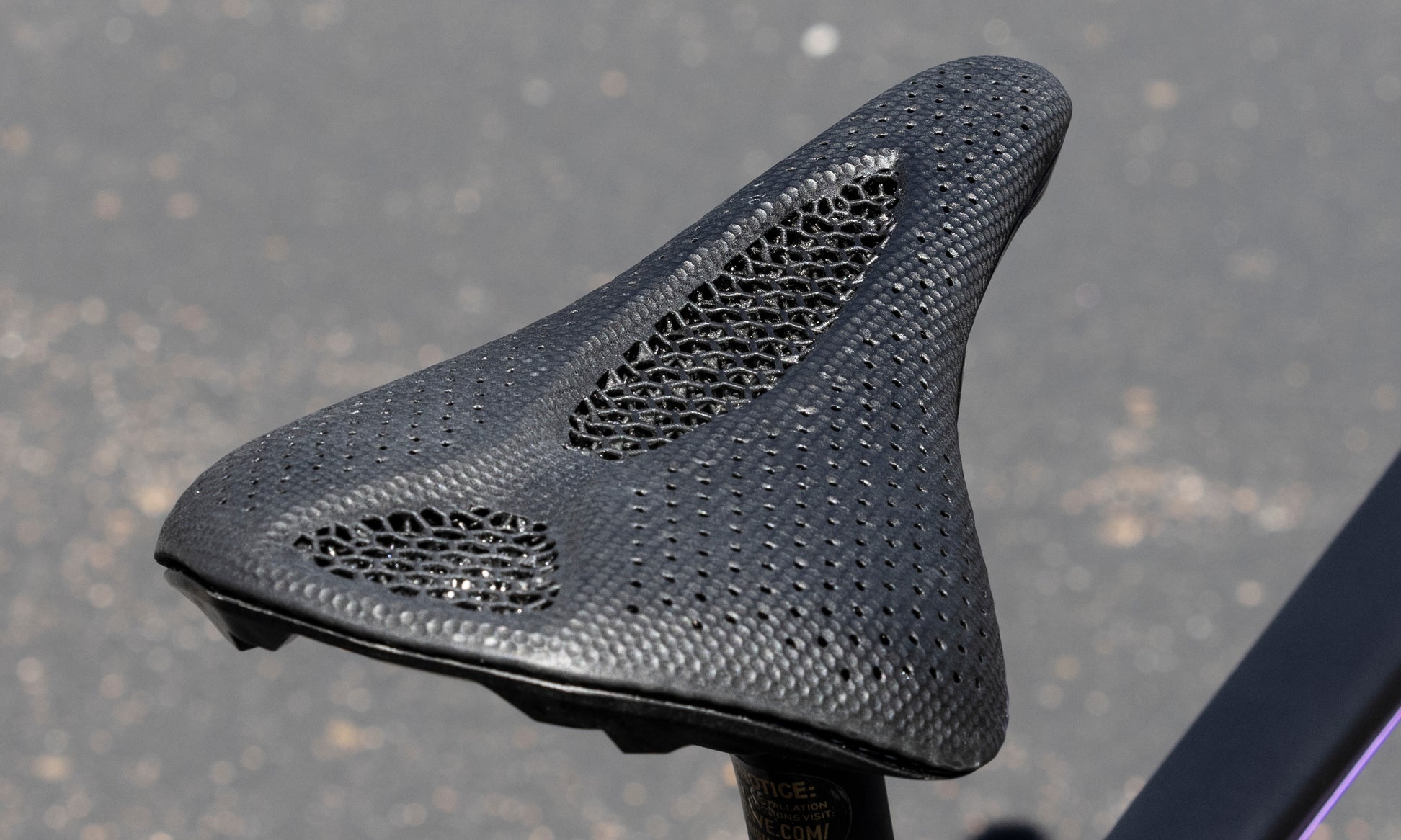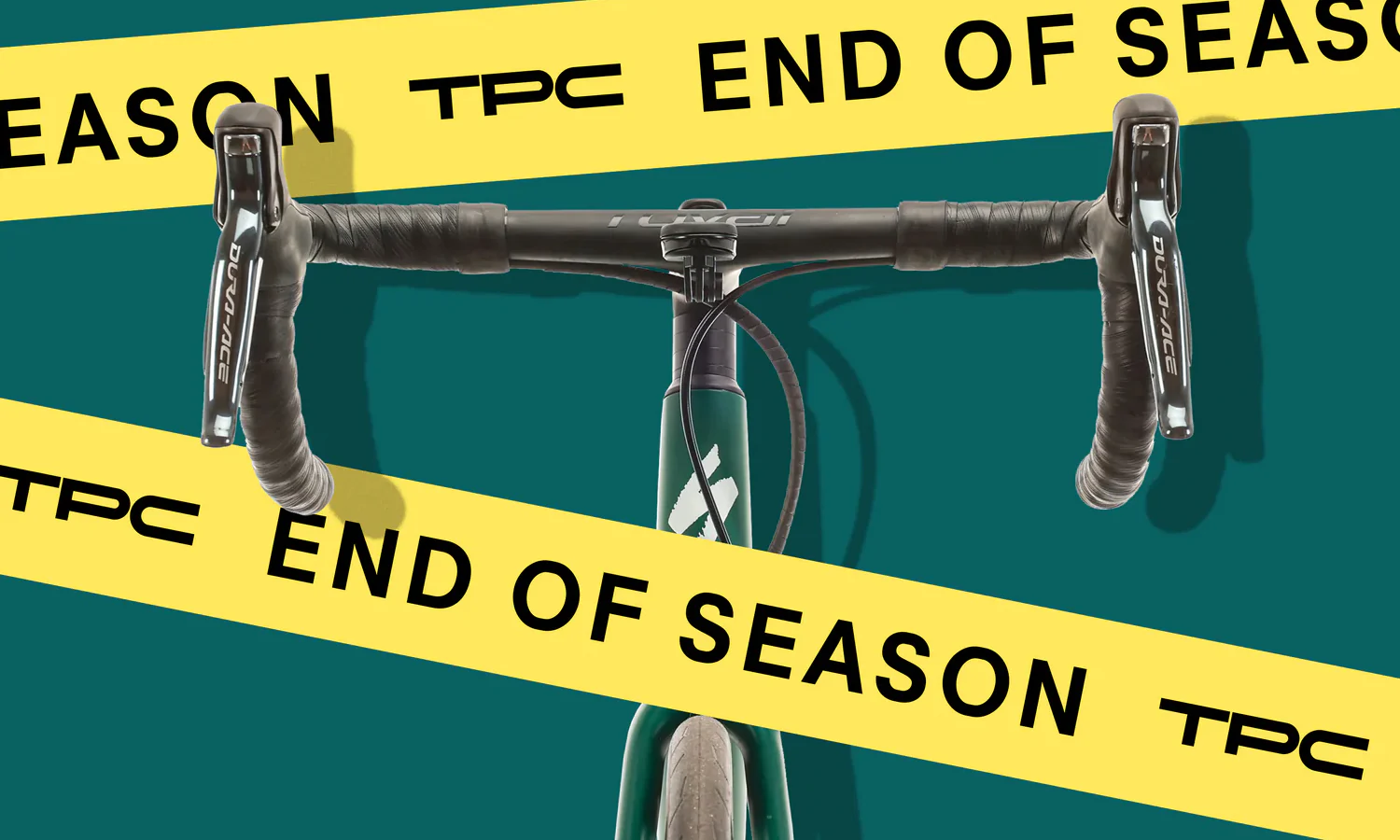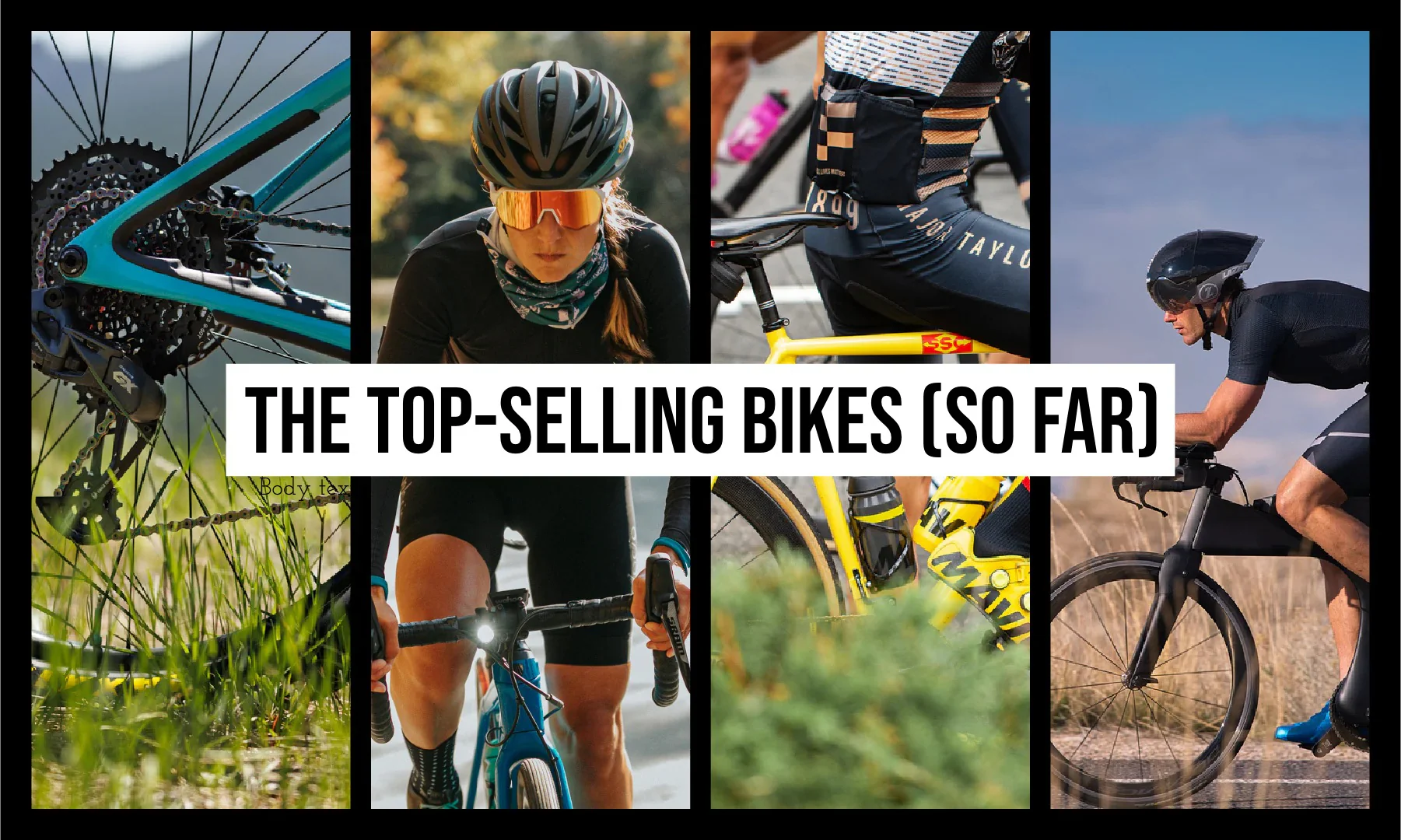Putting in miles at this time of the year often takes extra grit.
Winter is a tough time for cyclists. Your bike probably isn’t getting ridden as much as it should. If you’re partaking in holiday festivities and holiday snacks, then your fitness has likely taken a dive.
Rapha’s Festive 500 challenge is the perfect way to get you off the couch to finish the year and start the next off with a bang. The challenge, which you can join on Strava, involves riding 500 kilometers (310.7 miles) between Christmas Eve and New Year’s Day (Dec. 24th-31st).
The Festive 500 is now in its 14th year, and thousands of riders around the world will join up to give it their best shot. For most, making it to the finish will be tough. But that’s why we do it, right? Nothing feels better than accomplishing your goal. If you’re giving the Festive 500 challenge a go this year, these are our top tips to complete 500 km in 8 days.
1. Make a Plan/Schedule and Stick to It
 This is an extreme example from Janeen McCrae, but spreadsheets and calendars can become a secret weapon.
This is an extreme example from Janeen McCrae, but spreadsheets and calendars can become a secret weapon.
Ambitious goals are rarely accomplished simply by “winging it.” Beyond the physical challenge, the hardest part of Festive 500 is fitting the required mileage into a limited number of days. If you have holiday, family, or work obligations, then establishing a solid schedule is even more important.
Your plan doesn’t need to be complicated. Whether you’re riding 62.5 km (38.8 mi) every day, or doing all 500k in a single 30 hour ride, if you have your rides pre-scheduled, then the likelihood of you actually completing them goes up exponentially.
 My plan this year is to knock out about half of the miles in the 3 days after Christmas (I worked this out with my wife ahead of time). Then I'll finish it off with a series of ~1 hour trainer rides in the mornings and evenings (I'm very used to doing two rides a day).
My plan this year is to knock out about half of the miles in the 3 days after Christmas (I worked this out with my wife ahead of time). Then I'll finish it off with a series of ~1 hour trainer rides in the mornings and evenings (I'm very used to doing two rides a day).
I’d also suggest trying to frontload as many miles as possible. Banking miles early reduces stress and gives you more flexibility later in the week if you get hit with fatigue or other conflicts. Ultimately, your plan also needs to work with your fitness and abilities. If a long ride will wreck you, then maybe it’s more feasible to do 40 miles each day. If you know you struggle to ride consecutive days, then maybe 80 miles every other day is better.
Whatever your plan is, the key thing is that you stick to it. Understand the difference between motivation and discipline. Chances are, your motivation will wane. But having a plan and the discipline to stick to it is what will ultimately get you to the finish.
2. Stay Fueled DURING Your Rides
 Eat and drink at every opportunity. Many newer riders don't eat enough on the bike.
Eat and drink at every opportunity. Many newer riders don't eat enough on the bike.
If you’re upping your mileage, you’re going to need to eat more. But the key isn’t stuffing your face with as much food as possible when you get off the bike, it’s fueling consistently during your rides. Not only does fueling on the bike improve your performance, but it will also keep you from getting too run down during the week, which will improve your ability to recover and keep riding later.
If you’re not used to fueling on the bike, the key is eating (and drinking) regularly in small quantities. For most, eating a gel, a few gummies, or part of an energy bar every 30-45 minutes will be enough. Keep eating your entire ride, even if you don’t feel hungry. You’re not just fueling for the here and now, but for the future.
During many of my long rides I actually set alerts on my head unit that remind me to eat. Even if I’m only 5-10 minutes from home, I will eat. When you’re going big, every calorie counts.

Skratch Labs Super High-Carb Drink Mix Lemons and Limes 8-Serving Resealable Pouch
$41.95

Tailwind Nutrition Endurance Fuel Caffeinated Hydration Mix
$21.99
"Regular" food works great, but if you’re not sure what to eat on the bike, check out my list of my favorite on-the-bike nutrition and hydration products. One thing I plan to use on every ride is a carb mix in my bottles. It’s an easy way to stay on top of my calories while also staying properly hydrated.
3. Keep Most of Your Riding Easy
 Always keep the easy miles easy.
Always keep the easy miles easy.
For Festive 500 or any cycling challenge where you’re taking on more riding volume, the vast majority of your miles should be easy. This point should be obvious, but it’s easy to forget. Riding friends, strangers passing you, and Strava PRs can all entice you into dropping the hammer when you should be holding back. Unless you’re super fit and or experienced with high-volume training, this isn’t the time to knock out tough work-outs or chase PRs. Remember: it’s about the big picture, and ideally no single ride should compromise your ability to complete future rides.
I ride with a power meter, which makes it easy to keep myself in check and stay in the right zones. You could also use a heart rate monitor, or if you prefer to ride by feel, try to keep the majority of your riding at an effort level where you can easily speak in complete sentences or hold a conversation. You’ll go slower, but finish stronger.
4. Prioritize Recovery, Especially Sleep
 Take care of your body off the bike. Recovery is the key to success.
Take care of your body off the bike. Recovery is the key to success.
There are a lot of components to recovery, but the aspect that requires the most attention is sleep. Many working adults already have poor sleep hygiene. But the Festive 500 is the perfect opportunity to clean it up, even if it’s just for the week. You’re already committing to riding a lot. Commit to getting the sleep you need to recover, and completing 39 miles a day (or whatever your plan is) will feel a lot easier.
For me, the key is actually going to bed at a reasonable time. That means committing to an earlier bedtime (for me, 10 pm vs. midnight) and changing up my routine to accommodate that. The hardest part for me is putting down screens before actually getting under the sheets. But I will do it. I must.

One of the best products I've purchased this year is a sleep mask. It's cheap, and it forces me to put the screens down. Combine it with rain noises and I'm OUT in less than 15 minutes. Photo: Mavogel
If you can get your sleep dialed, then everything else you do — eating well, reducing stress, foam rolling — are all bonuses. The better you can recover after your long rides, the easier it will be to get on the bike later.
5. Increase Your Overall Comfort
 Do you have enough layers to ride happy in any weather?
Do you have enough layers to ride happy in any weather?
You won’t be able to put in the necessary hours if you’re miserable and in constant pain. Devote some attention to optimizing your comfort on the bike before you start the Festive 500. This could mean dialing in your clothing if you're riding outside, or your touchpoints if you're not used to long hours in the saddle.
There's an old Norwegian saying, “There's no such thing as bad weather, just inappropriate clothing.” If you’re riding in harsh winter weather, the right gear can be the difference between going the distance and aborting your ride early. If you need layering tips, check out our winter riding essentials guide.
Since the Festive 500 requires many of us to spend more time in the saddle than we’re used to, it’s also likely that you’ll develop some new pain points or aggravate some old ones. It's best to address issues before they flare up. For some of us, that means dialing in your saddle height, or if you want to go all out and have the time/money, getting a professional bike fit to prevent potential injury.
 I got a Specialized Power Pro Mirror saddle this year and expect my butt to be much happier than last year.
I got a Specialized Power Pro Mirror saddle this year and expect my butt to be much happier than last year.

Chamois Butt'r Original 8oz Tube
$19.99
It could mean applying a light layer (it should always be a LIGHT layer) of chamois cream before and during rides to prevent chafing and saddle sores. If you don’t own any, I highly recommend getting at least a pair (or ideally two, so you can rotate) of good cycling shorts/bibs with a high-quality chamois. If you hate your current saddle, before you start the best time to find a comfortable saddle that fits properly.
If you’re riding the Festive 500 indoors, then this might be the perfect time to upgrade your trainer dungeon. Luxuries like rocker plates, more powerful fans, dehumidifiers, and trainer desks make a huge difference in how long you can happily pedal inside.
6. Find Partners and Share Your Goals
 Good company is a performance enhancer.
Good company is a performance enhancer.
The most effective motivator for completing the Festive 500 is another person or group who can keep you accountable. This year, I’m doing the challenge with my wife. We can encourage each other, ride together, and make sure we both stay on track. Your partners don’t even need to be doing the Festive 500 challenge. Just having someone to ride with from time-to-time can have a positive effect on your motivation and perceived effort.
Even if you plan to ride alone, it's a good idea to let other people know about your goals. Just announcing that you’re going to complete (notice I said “going to” not “trying to”) the Festive 500 challenge to someone — a friend, a family member, the internet, your dog — can be enough to keep you on the horse.
7. Use This as an Opportunity To Discover New Things
 New roads and novel experiences make hard rides more fun.
New roads and novel experiences make hard rides more fun.
A couple of years ago I did a 30-day riding challenge where I rode at least an hour a day for an entire month. The challenge quickly became mind-numbing torture, and one of the things that kept me sane was purposely deviating from the riding routes I was accustomed to.
Exploring new roads and seeing new things made each day feel fresh, so my motivation stayed high. The Festive 500 is a great excuse to turn down that road you’ve never ridden. Maybe it leads nowhere. But getting turned around while exploring is way more engaging than riding the same tired route over and over.
If you’re riding an indoor trainer, this will be much harder. Chances are, most Zwift riders haven’t hit every route available in its virtual world, so there’s that. But my suggestion here would be to explore TV shows, movies, music, and audiobooks that you normally wouldn’t have the time or energy to binge.
Getting stuck on the trainer during last year’s Festive 500 is how I finally got around to watching Stranger Things on Netflix. It’s not my usual type of show, but I loved it, and I never would have started it otherwise!
8. Find Inspiration to Stay Motivated
We love stories of riders overcoming challenges through perseverance and determination. Festive 500 is the perfect time of year to seek these stories out. Good stories will inspire you to keep going and push through the pain.
There are too many TV, movie, and book options for me to list them all, but check out my old “Best YouTube Channels” list. YouTube is full of content creators who do a great job of keeping the riding stoke high.
If you want a book, I recommend Slaying the Badger, which document’s Greg Lemond’s heroic defeat of cycling legend Bernard Hinault to win his first Tour de France. Check out the story Lydia Tanner wrote for us about completing the entire Festive 500 in a single push.
Almost as useful as stories of triumph, are stories of failure. In sport, failure is the other side of the coin. The Festive 500 challenge is ambitious for most, and there is a chance that you can’t complete it. What I find helpful is seeing relatable stories where riders hit the wall. My favorite series for watching riders attempting (and often failing) overly ambitious high-mileage rides is VC Adventures' “Impossible Route” series.
Also, failure isn’t “failing.” It’s a stepping stone toward future sucess. Don’t stress or beat yourself up over it. You’re human. You’ll learn from it. Often, it ends up becoming a funny anecdote about where you went wrong. You can laugh about it with fellow cyclists, because we all ride bikes, and can understand.
Good luck this year!

























